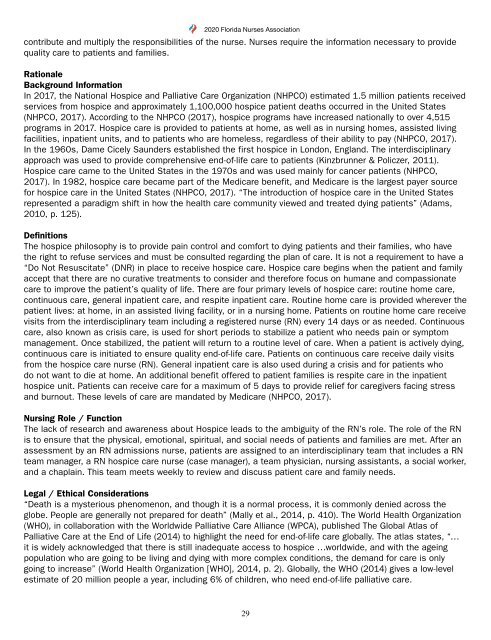2020 FNA Book Of Reports
Create successful ePaper yourself
Turn your PDF publications into a flip-book with our unique Google optimized e-Paper software.
<strong>2020</strong> Florida Nurses Association<br />
contribute and multiply the responsibilities of the nurse. Nurses require the information necessary to provide<br />
quality care to patients and families.<br />
Rationale<br />
Background Information<br />
In 2017, the National Hospice and Palliative Care Organization (NHPCO) estimated 1.5 million patients received<br />
services from hospice and approximately 1,100,000 hospice patient deaths occurred in the United States<br />
(NHPCO, 2017). According to the NHPCO (2017), hospice programs have increased nationally to over 4,515<br />
programs in 2017. Hospice care is provided to patients at home, as well as in nursing homes, assisted living<br />
facilities, inpatient units, and to patients who are homeless, regardless of their ability to pay (NHPCO, 2017).<br />
In the 1960s, Dame Cicely Saunders established the first hospice in London, England. The interdisciplinary<br />
approach was used to provide comprehensive end-of-life care to patients (Kinzbrunner & Policzer, 2011).<br />
Hospice care came to the United States in the 1970s and was used mainly for cancer patients (NHPCO,<br />
2017). In 1982, hospice care became part of the Medicare benefit, and Medicare is the largest payer source<br />
for hospice care in the United States (NHPCO, 2017). “The introduction of hospice care in the United States<br />
represented a paradigm shift in how the health care community viewed and treated dying patients” (Adams,<br />
2010, p. 125).<br />
Definitions<br />
The hospice philosophy is to provide pain control and comfort to dying patients and their families, who have<br />
the right to refuse services and must be consulted regarding the plan of care. It is not a requirement to have a<br />
“Do Not Resuscitate” (DNR) in place to receive hospice care. Hospice care begins when the patient and family<br />
accept that there are no curative treatments to consider and therefore focus on humane and compassionate<br />
care to improve the patient’s quality of life. There are four primary levels of hospice care: routine home care,<br />
continuous care, general inpatient care, and respite inpatient care. Routine home care is provided wherever the<br />
patient lives: at home, in an assisted living facility, or in a nursing home. Patients on routine home care receive<br />
visits from the interdisciplinary team including a registered nurse (RN) every 14 days or as needed. Continuous<br />
care, also known as crisis care, is used for short periods to stabilize a patient who needs pain or symptom<br />
management. Once stabilized, the patient will return to a routine level of care. When a patient is actively dying,<br />
continuous care is initiated to ensure quality end-of-life care. Patients on continuous care receive daily visits<br />
from the hospice care nurse (RN). General inpatient care is also used during a crisis and for patients who<br />
do not want to die at home. An additional benefit offered to patient families is respite care in the inpatient<br />
hospice unit. Patients can receive care for a maximum of 5 days to provide relief for caregivers facing stress<br />
and burnout. These levels of care are mandated by Medicare (NHPCO, 2017).<br />
Nursing Role / Function<br />
The lack of research and awareness about Hospice leads to the ambiguity of the RN’s role. The role of the RN<br />
is to ensure that the physical, emotional, spiritual, and social needs of patients and families are met. After an<br />
assessment by an RN admissions nurse, patients are assigned to an interdisciplinary team that includes a RN<br />
team manager, a RN hospice care nurse (case manager), a team physician, nursing assistants, a social worker,<br />
and a chaplain. This team meets weekly to review and discuss patient care and family needs.<br />
Legal / Ethical Considerations<br />
“Death is a mysterious phenomenon, and though it is a normal process, it is commonly denied across the<br />
globe. People are generally not prepared for death” (Mally et al., 2014, p. 410). The World Health Organization<br />
(WHO), in collaboration with the Worldwide Palliative Care Alliance (WPCA), published The Global Atlas of<br />
Palliative Care at the End of Life (2014) to highlight the need for end-of-life care globally. The atlas states, “…<br />
it is widely acknowledged that there is still inadequate access to hospice …worldwide, and with the ageing<br />
population who are going to be living and dying with more complex conditions, the demand for care is only<br />
going to increase” (World Health Organization [WHO], 2014, p. 2). Globally, the WHO (2014) gives a low-level<br />
estimate of 20 million people a year, including 6% of children, who need end-of-life palliative care.<br />
29

















